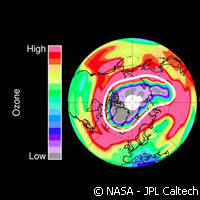Long cold period triggers greater ozone damage
An international team of researchers has discovered that the Arctic's ozone layer lost even more ground earlier this year. Presented in the journal Nature, the NASA-led study shows how an unusually prolonged period of major low temperatures in the stratosphere during the winter and spring seasons triggered further depletion of the ozone layer. Extending some 15 to 35 kilometres above the surface, the stratosphere ozone layer is what protects Earth and its life forms from the Sun's harmful ultraviolet rays by absorbing more than 97% of these rays. Researchers from Canada, Denmark, Finland, Germany, Japan, the Netherlands, Russia, Spain and the United States compared the damage wrought on the ozone earlier this year to what was observed in the Antarctic, where an ozone 'hole' has emerged each spring since the 1980s. The ozone levels at the onset of the Arctic winter are usually much greater than those at the start of the Antarctic winter. The data show that the cold period in the Arctic lasted for more than a month at a number of altitudes; this period was the longest ever seen before in Arctic winter studies. This extension of cold is responsible for the unprecedented ozone loss. The team says more research is needed to identify the factors that led to the extended cold period. Professor Kaley Walker, a physicist at the University of Toronto in Canada and co-author of the study, says: 'In the 2010-11 Arctic winter, we did not have temperatures that were lower than in the previous cold Arctic winters. What was different about this year was that the temperatures were low enough to generate ozone-depleting forms of chlorine for a much longer period of time. Arctic ozone loss events such as those observed this year could become more frequent if winter Arctic stratospheric temperatures decrease in future as Earth's climate changes.' In order to get a handle on the problem, the researchers assessed a comprehensive set of measurements that comprised daily global observations of trace gases and clouds from NASA's Aura and CALIPSO spacecraft, meteorological data and atmospheric models, and ozone measured by instrumental balloons. 'Each of the balloon and satellite measurements included in this study were absolutely necessary to understand the ozone depletion we observed this past winter,' Professor Walker explains. 'To be able to predict future Arctic ozone loss reliably in a changing climate, it is crucial that we maintain our atmospheric measurement capabilities.' They found that this year's ozone loss materialised in an area that is significantly smaller than the ozone holes of Antarctica. The difference is due to the Arctic polar vortex, a persistent large-scale cyclone within which the ozone loss occurs. Experts say that despite its compact size, around 40% smaller than an Antarctic vortex, the Arctic polar vortex is more mobile and moves over densely populated northern regions. The team provides insight into how increases in surface ultraviolet radiation are triggered by decreases in overhead ozone. These in turn have a negative impact on humans and other creatures on the planet. The researchers go on to say that the 1989 Montreal Protocol, a global treaty that restricts the production of ozone-depleting substances, helps environmentalists in their fight to keep chlorine levels lows and thwart the emergence of an Arctic ozone hole each spring.For more information, please visit:Nature:http://www.nature.com/University of Toronto:http://www.utoronto.ca/
Countries
Canada, Germany, Denmark, Spain, Finland, Japan, Netherlands, Russia, United States



